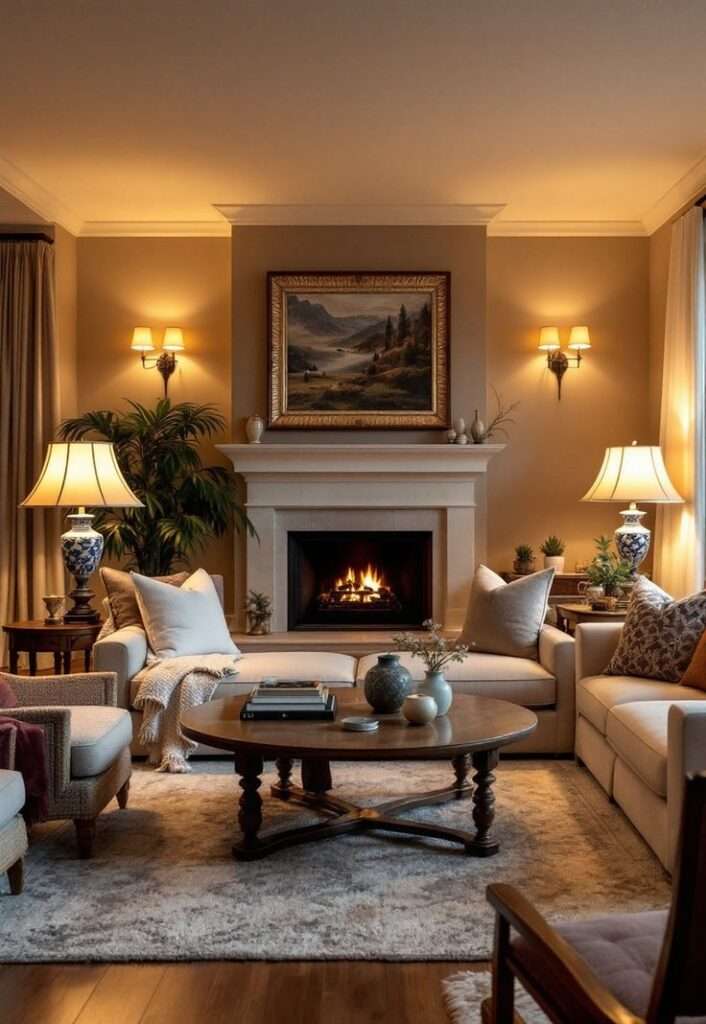Lighting is one of the most transformative elements in interior design, influencing the mood, functionality, and aesthetic of a space. However, many homeowners overlook the importance of layering light. Instead of relying on a single light source, layering ambient, task, and accent lighting creates a dynamic, versatile environment that can be adjusted to suit various activities and moods.
At Scale & Structure, we specialize in creating thoughtfully designed spaces that highlight the power of lighting. Whether you’re designing a living room, kitchen, or home office, understanding the importance of lighting layers can make all the difference in how your space feels and functions.
In this blog, we’ll explore how to use these three types of lighting to enhance your home’s design.

What Are Lighting Layers?
Lighting layers refer to the strategic combination of different types of lighting—ambient, task, and accent—to create a balanced, flexible, and visually appealing environment. Each layer serves a distinct purpose and contributes to the overall atmosphere of the space.
1. Ambient Lighting: The Base Layer
Ambient lighting, also known as general lighting, is the primary source of light in a room. It provides overall illumination, allowing people to navigate and use the space comfortably. Ambient lighting sets the tone of the room and ensures the space is not too dim or too bright.
Characteristics of Ambient Lighting:
- Provides even illumination across the room.
- Typically soft and diffused, avoiding harsh shadows.
- Allows for general movement and functionality within a space.
Types of Ambient Lighting:
- Ceiling-mounted fixtures: Recessed lights, chandeliers, or pendant lights that provide broad illumination.
- Flush mounts and semi-flush mounts: Fixtures that sit close to the ceiling, creating a more uniform spread of light.
- Natural light: Maximize windows and glass doors to allow daylight to flood the room during the day.
How to Use Ambient Lighting:
Ambient lighting should create a comfortable, evenly lit environment without overpowering the space. In a living room, for example, a central ceiling fixture, like a chandelier or flush-mount light, can provide the foundation for your lighting scheme.
2. Task Lighting: Focused Illumination for Specific Activities
While ambient lighting offers general illumination, task lighting is focused on providing light for specific activities. Whether you’re reading a book, cooking, or working at a desk, task lighting helps illuminate areas where precision and focus are required.
Characteristics of Task Lighting:
- Provides direct light to a specific area for activities.
- Bright and focused, allowing for clear visibility for detailed tasks.
- Helps reduce eye strain, making it ideal for tasks requiring concentration.
Types of Task Lighting:
- Desk lamps: Ideal for home offices or study areas where focused lighting is essential.
- Under-cabinet lighting: A great option for kitchens to illuminate countertops while cooking.
- Reading lights: Placed beside chairs or in bedrooms to provide targeted light for reading.
- Track lighting: Can be directed to specific work areas, such as kitchen counters or office spaces.
How to Use Task Lighting:
In your kitchen, task lighting can be incorporated under cabinets or above work surfaces to ensure adequate lighting while cooking. Similarly, in a home office, a desk lamp with adjustable brightness can provide the focused illumination needed for productivity.
3. Accent Lighting: Highlighting Features and Adding Drama
Accent lighting is the most decorative layer of lighting. Its purpose is to highlight key features in a room, such as artwork, architectural details, or a beautiful piece of furniture. Accent lighting adds drama and creates a sense of depth, dimension, and interest within a space.
Characteristics of Accent Lighting:
- Provides focused light to highlight a specific object or feature.
- Creates visual interest and enhances the atmosphere.
- Adds a layer of sophistication and warmth to the room.
Types of Accent Lighting:
- Spotlights and track lighting: Used to highlight artwork, sculptures, or other focal points.
- Wall sconces: Mounted on walls to draw attention to key areas of the room.
- Picture lights: Specifically designed to illuminate artwork, ensuring the details are visible and well-lit.
- LED strips: Often used for highlighting architectural features, such as coves or bookshelves.
How to Use Accent Lighting:
In a living room, accent lighting can be used to highlight a piece of artwork or a unique architectural feature, such as a fireplace or exposed brick wall. In a bedroom, wall sconces with dimming options can create a cozy, intimate atmosphere while accentuating the decor.
The Importance of Layering Lighting
To achieve a balanced, well-lit room, it’s essential to combine all three types of lighting—ambient, task, and accent. Each layer serves a distinct purpose, but together, they create a versatile lighting plan that enhances the room’s functionality and aesthetic.
How to Layer Lighting:
- Start with Ambient Lighting: Choose a central light source that provides even illumination. This could be a ceiling fixture, recessed lighting, or natural light during the day.
- Add Task Lighting: Next, incorporate focused lighting for specific tasks, such as under-cabinet lighting in the kitchen or a desk lamp in the home office.
- Finish with Accent Lighting: Add finishing touches by highlighting key features, such as artwork or architectural elements, with spotlights or accent lamps.
The beauty of layered lighting is its adaptability. You can adjust the intensity and focus of each layer depending on the time of day, the activities you’re doing, or the mood you want to create. This flexibility allows you to use your lighting design for different purposes and enhance the overall experience of the space.
Practical Tips for Layering Lighting in Different Rooms
Each room in your home requires a thoughtful lighting plan that balances all three layers of light. Here are a few examples:
1. Living Room
- Ambient: A chandelier or a central ceiling fixture to provide general lighting.
- Task: Table lamps beside seating areas for reading or work.
- Accent: Highlight artwork with picture lights or use wall sconces to create ambiance.
2. Kitchen
- Ambient: Overhead recessed lighting or pendant lights above islands and counters.
- Task: Under-cabinet lighting to illuminate countertops and cooking areas.
- Accent: LED strips under shelves or in glass cabinets to highlight dishes and decor.
3. Home Office
- Ambient: Recessed lighting or overhead fixtures for overall illumination.
- Task: A desk lamp or adjustable task lighting to provide focused light for reading or writing.
- Accent: Accent lighting on bookshelves or artwork to add interest and create a welcoming atmosphere.
4. Bedroom
- Ambient: A ceiling light or dimmable recessed lighting for a soft, relaxing atmosphere.
- Task: Reading lamps or bedside lamps for focused light during nighttime reading or other tasks.
- Accent: Wall-mounted sconces or decorative lighting to highlight the bed frame or artwork.
Why Choose Scale & Structure for Your Lighting Design?
At Scale & Structure, we understand that lighting is essential in creating spaces that are both functional and beautiful. Our team of experts is skilled in designing lighting plans that incorporate ambient, task, and accent illumination to elevate your home’s design.
Why Work with Scale & Structure:
- Customized Lighting Solutions: We tailor lighting designs to suit your space’s needs, style, and function.
- Expert Design Guidance: Our experienced team will guide you in selecting the right fixtures and light layers to create a balanced, well-lit room.
- Holistic Interior Design: We seamlessly integrate lighting with your overall interior design concept to ensure every detail is perfect.
Ready to transform your home with layered lighting? Contact Scale & Structure today, and let us help you design a lighting plan that enhances the beauty, functionality, and ambiance of your space.



